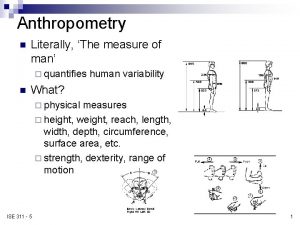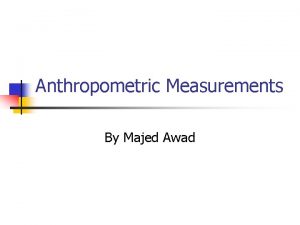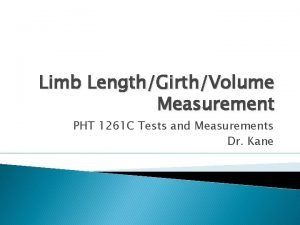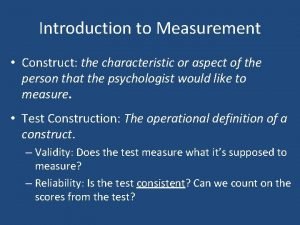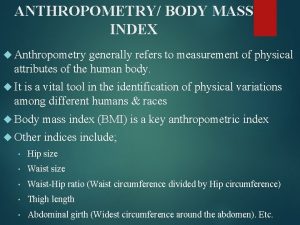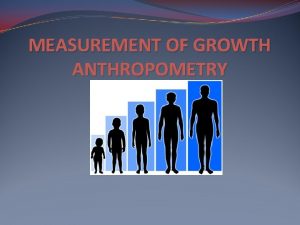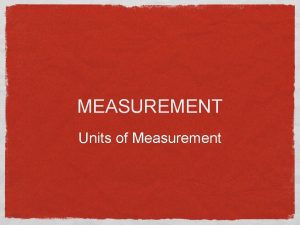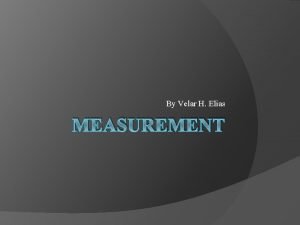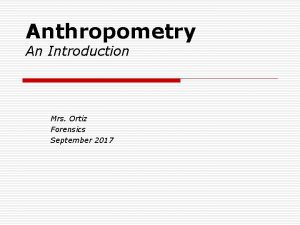Anthropometric Principles Introduction Anthropometry refers to the measurement

























































- Slides: 57

Anthropometric Principles

Introduction • Anthropometry refers to the measurement of the human individual for the purposes of understanding human physical variation. • This was used by Alphonse Bertillon to set up one of the first biometrics systems. • Greek anthropos (man) and metron (measure)

Definition of Anthropometry The part of anthropology (study of humans) having to do with measurements of the human body to determine differences in races, individuals, etc… Source : Webster’s New 20 th Century Dictionary (1970)

Definition of Anthropometry The study of human body measurements esp. on a comparative basis. Source: Merriam Webster’s Collegiate Dictionary (1993)

Definition of Anthropometry is a science that deals with the measurement of size, weight, and proportions of the human body. It is empirical (experimentally derived) in nature and has developed quantitative methods to measure various physical dimensions. (Chaffin, 1984)

Anthropometry • During the early 20 th century, anthropometry was used extensively by anthropologists in the United States and Europe. One uses became the attempted differentiation between differences in the races of man, and it was often employed to show ways in which races were "inferior" to others. • Today, anthropometry plays an important role in industrial design, clothing design, ergonomics and architecture where statistical data about the distribution of body dimensions in the population are used to optimize products.

Bertillon and Criminology • In 1883 Bertillon developed a system of identification depending on the unchanging character of certain measurements of parts of the human frame. • He concluded that if these measurements were made and recorded systematically every single individual would be found to be perfectly distinguishable from others. • The French adopted the Bertillon method into their criminal system, while the English was adopting the use of fingerprinting for identification

History of Anthropometry • 1883 - Alphonse Bertillon: system of identification depending on the unchanging character of certain measurements of parts of the human body • 1884: 241 multiple offenders were identified • “Bertillonage”- first adapted by the French police • 1887: introduced in the United States by Major Mc. Claughry, the translator of Bertillon's book, when he was the warden of the Illinois State Penitentiary at Joliet.

Alphonse Bertillon: Forensic Anthropometry

History of Anthropometry • 1888: Francis Galton starts research on “Finger Prints” to further anthropometry • 1892: Francis Galton publishes Finger Prints • 1894: England adopted the system. • 1903: Will West & William West

Industrial Engineering • Work Methods • Facility Layout • Work Flow Anthropometry Psychology Biomechanics Physiology Occupational Ergonomics Methods Analysis Workplace Design Machine & Equipment Design Tool Design Operator Assignments & Job Design

Anthropometric Data • Used to specify dimensions of workspaces, equipment, furniture, clothing so as to ‘fit the task to the man’ • Avoid mismatches between the dimension of equipment, products to the user.

Why Anthropometric Data Important? 1. Optimize the dimensions of a diverse range of items. Example, length of toothbrushes, size of toolkits, size of clothes for Malaysian… others. 2. Good example is T-shirt size Large for Malaysians maybe size Small for New Zealand Rugby club.

Human Variability • • Size Range of Motion Strength Endurance Stress tolerance Intelligence Dexterity etc.

The Story of Lacy and Andrew Does one size fit all? Lacy is 4’ 10” (147 cm) Andrew is 6’ 10” (208 cm)








Love conquers all – even anthropometry!


Anthropometric Measuring Tools Tape Goniometer Medical scale Spreading Caliper Sliding Calipers: large and small Anthropometer



Anthropometric Measuring Techniques • Weight • Stature • Posture: – Standing – Frankfort – Sitting • Arm Span • Head Length • Head Breadth • Ear-to-Head Height • Nasal Length • Nasal Breadth • Skeletal Index = Sitting Height x 100/Stature • Cephalic Index = Head Breadth x 100/Head Length • Nasal Index = Nasal Breadth x 100/Nasal Length • Span/Stature Index = Arm Span x 100/ Stature • Cranial Capacity




Anthropometry Today • Biometrics • Nutrition and wellness – Weight Training • Ergonomics – dynamic anthropometry: Measurements taken on and around the figure when it is in any position other than the fixed ones. – Everyday life • Evolutionary Significance – Changes in humans overtime • Monitor growth in children – Cranial Anthropometry

Where to get Anthropometric Data? • Military? • Hospital? • Ministry of Health? Basically there are problems because the way data obtained are not standard. Meaning that Researcher A uses his method while Researcher B uses his own method.

Static Dimensions • Measurements taken when the body is in a fixed (static) position. • They consist of skeletal dimensions (between the centers of joints, such as between the elbow and the wrist) or of contour dimensions (skin surface dimensions such as head circumference • Body measurements vary as a function of age, sex, and for different ethnic populations. • In connection with age, for example, stature and related dimensions (lengths and heights) generally increase until the late teens or early twenties, remain relatively constant throughout early adulthood, and decline from early-to-middle adulthood into old age (Stoudt, 1981). • An exception is the length of the ears, which continue to grow throughout life. 34

35

36

Dynamic (Functional) Dimensions • dimensions are taken under conditions in which the body is engaged in some physical activity. • In most physical activities (whether one is operating a steering wheel, assembling a mousetrap, or reaching across the table for the salt) the individual body members function in concert • The practical limit of arm reach, for example, is not the sole consequence of arm length; the limit is also affected by shoulder movement, partial trunk rotation, possible bending of the back, and the function to be performed by the hand. 37

• possible interactions by various body members of a forklift truck operator. • This figure is an illustration of what is sometimes called somatography in that it shows the three views of the operator: the frontal, side, and top. 38

• Although there is no systematic procedure for translating static anthropometric data into dynamic measurements, Kroemer (1983) offers the following rules of thumb that may be helpful: 39

Principles in the Application of Anthropometric Data • three general principles for applying anthropometric data to specific design problems • each applies to a different type of situation 1. Design for Extreme Individuals 2. Designing for Adjustable Range 3. Designing for the Average 40

1. Design for Extreme Individuals • One should try to accommodate all (or virtually all) the population in question. • Limiting factor can dictate either a maximum or minimum value of the population variable or characteristic in question. • Designing for the maximum population value - appropriate strategy if a given maximum (high) value of some design feature should accommodate all (or virtually all) people. • Examples - heights of doorways, sizes of escape hatches on military aircraft, and strength of supporting devices (such as a trapeze, rope ladder, or workbench). • Designing for the minimum population value - appropriate strategy if a given minimum (low) value of some design feature has to accommodate all (or virtually all) people. • Examples - distance of a control button from the operator and the force required to operate the control 41

2. Designing for Adjustable Range • examples - automobile seats, office chairs, desk heights, and footrests. • In the design of such equipment, it frequently is the practice to provide for adjustments to cover the range from the 5 th percentile female to the 95 th percentile male of the relevant population characteristic (sitting height, arm reach, etc. ). • The use of such a range is especially relevant if there could be technical problems in trying to accommodate the very extreme cases (i. e. , 100 percent of the population. • Generally, designing for an adjustable range is the preferred method of design, but of course, it is not always possible. 42

3. Designing for the Average • First of all, there is no "average" individual. • A person may be average on one or two body dimensions, but because there are no perfect correlations it is virtually impossible to find anyone who is average on more than a few dimensions. • Often designers design for the average as a copout so that they do not have to deal with the complexity of anthropometric data. • A thorough analysis of the situation may prove that an average value is acceptable 43

5 th and 95 th Percentile • Standard deviation, σ x 1. 64 – MEAN = 5 th percentile • 1. 64 + MEAN = 95 th percentile. • σ x 2. 32 – MEAN = 1 st percentile • 2. 32 + MEAN = 99 th percentile • Using these data, you can compute a range of statures, leg lengths and others.


Applying Statistics to Design • Statistical information about body size is not directly applicable to a design problem. • Designer has to analyze anthropometric mismatches and then decide the anthropometric data which is appropriate to the problem. • A suitable percentile has to be chosen. • Example; a handicapped person in the university. Current accommodation have been made for normal people. If a handicap person registers, he must adapt to the normal situation. Adjustments must be made by university to accommodate him.

Minimum Dimensions • There are situations we need to use minimum dimensions for the comfort ability of most populations. • The door way must be no lower than minimum value. • Seat width must be no narrower than the largest hip width. • In a female or mixed-sex workforce, the body width of a pregnant woman is used.

Maximum Dimensions • A low percentile is chosen to determine the maximum height of a door latch so that the smallest adult in a population will be able to reach it. • In public transport, the seat must be low enough so that a short person can rest the feet on the floor. • The seat height must be no higher than 1 st or 5 th percentile.

Cost-Benefit Analysis • Sometimes, not necessary to use anthropometric data in all cases. • Often trade-offs between the assitional costs of designing to suit a wide range of people and the number of people who will ultimately benefit.

Trade-off • Example, the height of a car vs tall person. • If Mean for sitting is 90 cm with standard deviation of 5 cm, 50% driver can accommodate. • Increase ceiling height to 100 cm (95+5+5), 84% can accommodate. • Increase 5 cm more i. e. 105 cm will only accommodate extra 2% of the population. • Also increase drag and friction. • 5 th and 95 th percentile are often used to determine the dimensions of products.

Consequences of Mismatch • Designer must predict the consequences of mismatch- how serious they can be and who would be affected. • Example, the fire escape door. All people can handle it including children.

Mannequins • Crash test dummies is created based on 5 th and 95 th percentile data. • Expensive. • Nowadays use software. Example • www. sammiecad. com

Design for Everyone • The problems of design that suits everyone can be solved by 1. Make different sizes 2. Design adjustable products 3. Anthropometry and Personal Space

Make different sizes • Often heard of free-size shirts? • Most people can wear it. • The size is based on minimum dimensions of the population. • How about people who wanted size S, M, L, XXL, XXXL? • Designers must make shirts with different sizes for different races/countries.

Design Adjustable Products • Design the mechanism that can adjust with the ease of operation.

Anthropometry and Personal Space • Everyone have personal space. • Regard as an area of space that are preserved. • In the workplace, a minimum separation of desks or benches of approximately 1. 2 meters is necessary.

Summary • 5 th and 95 th percentile plays big role in determining the minimum value of dimensions of products. • Trade-off is unavoidable in designing products. • Use of mannequin is good for testing. • Design for everyone can be approached in several ways.
 Vital signs and anthropometric measurements
Vital signs and anthropometric measurements Static and dynamic anthropometry
Static and dynamic anthropometry Anthropometry
Anthropometry Newtonian anthropometric data
Newtonian anthropometric data Static and dynamic anthropometry
Static and dynamic anthropometry Engineering anthropometry
Engineering anthropometry Anthropometry
Anthropometry Z score for malnutrition
Z score for malnutrition Popliteal length
Popliteal length Vital signs and anthropometric measurements:
Vital signs and anthropometric measurements: Anthropometric assessment
Anthropometric assessment Rotameter introduction
Rotameter introduction Introduction to measurement
Introduction to measurement Hát kết hợp bộ gõ cơ thể
Hát kết hợp bộ gõ cơ thể Bổ thể
Bổ thể Tỉ lệ cơ thể trẻ em
Tỉ lệ cơ thể trẻ em Chó sói
Chó sói Chụp phim tư thế worms-breton
Chụp phim tư thế worms-breton Hát lên người ơi
Hát lên người ơi Các môn thể thao bắt đầu bằng tiếng bóng
Các môn thể thao bắt đầu bằng tiếng bóng Thế nào là hệ số cao nhất
Thế nào là hệ số cao nhất Các châu lục và đại dương trên thế giới
Các châu lục và đại dương trên thế giới Công thức tính độ biến thiên đông lượng
Công thức tính độ biến thiên đông lượng Trời xanh đây là của chúng ta thể thơ
Trời xanh đây là của chúng ta thể thơ Cách giải mật thư tọa độ
Cách giải mật thư tọa độ Làm thế nào để 102-1=99
Làm thế nào để 102-1=99 Phản ứng thế ankan
Phản ứng thế ankan Các châu lục và đại dương trên thế giới
Các châu lục và đại dương trên thế giới Thơ thất ngôn tứ tuyệt đường luật
Thơ thất ngôn tứ tuyệt đường luật Quá trình desamine hóa có thể tạo ra
Quá trình desamine hóa có thể tạo ra Một số thể thơ truyền thống
Một số thể thơ truyền thống Bàn tay mà dây bẩn
Bàn tay mà dây bẩn Vẽ hình chiếu vuông góc của vật thể sau
Vẽ hình chiếu vuông góc của vật thể sau Nguyên nhân của sự mỏi cơ sinh 8
Nguyên nhân của sự mỏi cơ sinh 8 đặc điểm cơ thể của người tối cổ
đặc điểm cơ thể của người tối cổ Thế nào là giọng cùng tên? *
Thế nào là giọng cùng tên? * Vẽ hình chiếu đứng bằng cạnh của vật thể
Vẽ hình chiếu đứng bằng cạnh của vật thể Tia chieu sa te
Tia chieu sa te Thẻ vin
Thẻ vin đại từ thay thế
đại từ thay thế điện thế nghỉ
điện thế nghỉ Tư thế ngồi viết
Tư thế ngồi viết Diễn thế sinh thái là
Diễn thế sinh thái là Dạng đột biến một nhiễm là
Dạng đột biến một nhiễm là Các số nguyên tố
Các số nguyên tố Tư thế ngồi viết
Tư thế ngồi viết Lời thề hippocrates
Lời thề hippocrates Thiếu nhi thế giới liên hoan
Thiếu nhi thế giới liên hoan ưu thế lai là gì
ưu thế lai là gì Khi nào hổ mẹ dạy hổ con săn mồi
Khi nào hổ mẹ dạy hổ con săn mồi Khi nào hổ con có thể sống độc lập
Khi nào hổ con có thể sống độc lập Sơ đồ cơ thể người
Sơ đồ cơ thể người Từ ngữ thể hiện lòng nhân hậu
Từ ngữ thể hiện lòng nhân hậu Thế nào là mạng điện lắp đặt kiểu nổi
Thế nào là mạng điện lắp đặt kiểu nổi Introduction of principles of marketing
Introduction of principles of marketing The gang plank
The gang plank Matching principle in accounting
Matching principle in accounting




